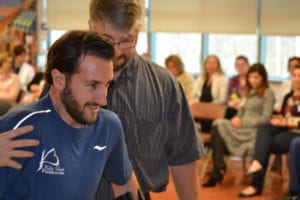Putting one foot in front of the other never looked so inspiring.
A freak sledding accident in Vermont in 2009 left Greg Durso, 31, of Stony Brook unable to use his lower body from his stomach muscles down. With the help of St. Charles Hospital’s rehabilitation center, he stood and walked across a room Dec. 13 in front of his family and dozens of hospital personnel for the first time since his accident.

Durso was aided by a clinical trial product called the Indego exoskeleton, which is a wearable robotic frame. St. Charles is one of nine hospitals in the United States conducting the clinical trial, and the only one on Long Island. Durso is the first patient at the hospital to take the technology for a spin.
“It’s just an incredible feeling to be up there and be walking again — putting weight on your legs,” Durso said after his groundbreaking stroll. “Each step is kind of like a leap of faith … a month ago I probably couldn’t have told you I’d be here today, so when I heard about this, I was so happy to have the opportunity to do this.”
Indego is the second FDA-approved exoskeleton device used for lower limbs. The device weighs about 26 pounds, and requires no backpack or external wires, as other similar devices have in the past. Currently the machine is operated by Durso’s chest muscles, but future incarnations of the device will allow electrical stimulation in the muscles so that a patient’s own legs will make the machine work, according to St. Charles Physical Medicine and Rehabilitation Medical Director Jennifer Semel. The FDA gave the machine clearance in March.
“The future is really limitless,” Semel said in an interview. “It’s really exciting to see people who haven’t been able to stand up in several years not only to be at the same height as their peers, but to be able to walk. It’s really uplifting.”
Semel said Durso has been using the device for about a month, and last week required a walker in addition to the exoskeleton to get around. He progressed to crutches for his Dec. 13 walk. Semel said the plan is for Durso to continue using the device for several months to gain a better understanding of the health benefits and the impact it has on a patient’s gait.
“I think I was a little skeptical because you realize people always tell you there’s going to be advances, there’s going to be this and that in the future,” Durso said. “But when you see this — I actually get up, I actually walk, I gave my sister a hug for the first time in eight years face to face — it’s pretty emotional and empowering, and it’s just exciting to see where the future is going to go with this technology.”
It was an emotional day for the members of the Durso family in attendance. Durso’s older sister, Jessica Giovan, fought back tears trying to describe seeing her brother walk again for the first time in eight years.
‘It’s just an incredible feeling to be up there and be walking again — putting weight on your legs … each step is kind of like a leap of faith.’
— Greg Durso
“I just saw him look so proud and happy,” she said. “He works so hard at everything he does, so to see him put one foot in front of the other, literally, was just unbelievable … the person you see now is the person he has always been. He has not, for one second, wavered in his personality since the accident. In fact, he has only increased his perseverance and his humor, and he lives everyday to make everyone around him feel like it’s okay.”
His dad, Richard Durso, said he couldn’t have imagined he’d be sitting where he was, watching his son walk, when he heard the news of the accident eight years ago. He credited his son’s positive attitude for keeping him on track. His mom, Jean Durso, called what she saw “unbelievable.”
Durso has competed in Iron Man races and marathons in his life — the former both pre and post accident — and said he hopes to be able to regain some of that lifestyle in the future.
“I love to do athletic things. I mean, it could be anything. I just want to be out there, have fun and live my life the way I want to do it,” he said. “For me that’s enough.”
The Indego devices cost about $80,000 each.




